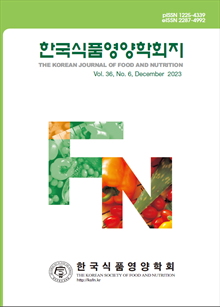간행물
한국식품영양학회지 KCI 등재 The Korean Journal of Food And Nutrition

- 발행기관 한국식품영양학회
- 자료유형 학술지
- 간기 격월간
- ISSN 1225-4339 (Print)2287-4992 (Online)
- 수록기간 1988 ~ 2024
- 주제분류 자연과학 > 생활과학 자연과학 분류의 다른 간행물
- 십진분류KDC 594DDC 641
권호리스트/논문검색
Vol. 30 No. 2 (2017년 4월) 25건
21.
2017.04
구독 인증기관 무료, 개인회원 유료
The aims of this study was to investigate the satisfactions with school food service and its influencing factors for elementary and middle school parents. We surveyed parents regarding their concerns about food ingredients and dietary life, perceptions of free school food service, the necessity of food supply systems such as school food service centers, and the satisfaction about the quality and management of school food services. Compared to the last year, concerns about food ingredients and dietary life as well as perceptions about free school food services decreased. The reported necessity of supply system such as school food service centers and co-purchasing was lower than in 2015. The satisfaction about the school food service decreased, compared to 2015. More individuals had higher concerns about local food and stated the necessity for school food supply systems, as well as a higher satisfaction about the quality and management of school food services. In conclusion, it is important to emphasize characteristics of school food services such as co-purchasing local foods.
4,000원
22.
2017.04
구독 인증기관 무료, 개인회원 유료
This study investigated the chemical composition of headspace gas from white-flowered lotus (Nelumbo nucifera Gaertner). Volatile flavor compositions of headspace from white-flowered lotus (floral leaf, stamen, flower stalk, stem) were investigated through the solid-phase microextraction method using polydimethylsiloxane-divinylbenzene fiber. The headspace was directly transferred to a gas chromatography-mass spectrometry. Sixty-three volatile flavor constituents were detected in the headspace of lotus floral leaves, and undecanoic acid (7.81%) was the most abundant component. Fifty-three volatile flavor constituents were detected in the headspace of lotus stamina, and isobutylidene phthalide (7.94%) was the most abundant component. Forty-four volatile flavor constituents were detected in the headspace of lotus flower stalks, and 3-butyl dihydrophthalide (11.23%) was the most abundant component. Fifty-nine volatile flavor constituents were detected in the headspace of lotus stems, and ligustilide (16.15%) was the most abundant component. The content of phthalides was higher in the headspace of flower stalks and stems, while alcohols and acids were the predominant compounds in lotus floral leaves.
4,000원
23.
2017.04
구독 인증기관 무료, 개인회원 유료
Muscle atrophy is characterized by a decrease in the mass of the muscle. With an increase in life expectancy and chronic illnesses, the incidence of muscle atrophy is increasing and the quality of life of patients is decreasing. Thus, reducing muscle atrophy is of high clinical and socio-economic importance. Mistletoe is a semi-parasitic plant that has been used as a traditional medicine in many countries to treat various human illnesses. It has been reported that Korean mistletoe extract (KME) has diverse biological functions including anti-tumor, anti-oxidant, anti-diabetic, anti-obesity properties, and extension of lifespan. Especially, we have recently reported that KME improves exercise endurance in mice, indicating its beneficial roles in enhancing the capacity of skeletal muscle. In this study, we investigated whether KME could activate the signaling pathway related to protein synthesis in a mouse model of muscle atrophy. Interestingly, KME efficiently activated the Akt/mTOR pathway, and Akt and mTOR are important signaling hub molecules for the acceleration of protein synthesis in muscle cells. In addition, KME also increased the activity of S6 kinase which is involved in the regulation of muscle cell size. Moreover, the ERK activity, required for transcription of ribosomal RNA for protein synthesis, was also enhanced in KME-treated mouse muscle. These data support the idea that KME increases muscle mass via increased protein synthesis. Our findings also suggest that Korean mistletoe might be a promising candidate for the development of functional foods that are beneficial for preventing muscle atrophy.
4,000원
24.
2017.04
구독 인증기관 무료, 개인회원 유료
To stabilize the supply of kimchi by extending the storage period of spring kimchi cabbage, this study manufactured kimchi from spring kimchi cabbage under varying storage conditions and periods, and analyzed their quality and sensory characteristics following the maturing period. Trimming loss was lowest in the group of plasma+reverse direction+predrying+ HDPE film processing. The salting yield of spring kimchi cabbage stored for 12 weeks was lower than that of spring kimchi cabbage stored for 6 weeks, and the kimchi yield was low in the pre-treatment group of spring kimchi cabbage stored for 12 weeks. The firmness was slightly different according to the storage period from one month of maturation. From the perspective of pH and acidity, the maturation in the reverse direction+pre-drying+HDPE film processing group was slower than that in the normal group (<0.05). In the sensory evaluation, the preference was increased in the low temperature storage processing group as the maturation period was increased (<0.05).
4,000원
25.
2017.04
구독 인증기관 무료, 개인회원 유료
This study investigated the stability of ethanolic extract from fermented Cirsium setidens Nakai (FCSN) in order to develop functional materials during different storage conditions. We evaluated pectolinarin and pectolinarigenin contents, total phenol content and antioxidant activity (DPPH radical scavenging activity and FRAP assay) of ethanolic extract from FCSN obtained by bioconverison at various temperatures (4, 25 and 50℃) and pHs (4.0, 7.0 and 10.0). Our results show that the pectolinarin, pectolinarigenin, and total phenol contents in ethanolic extract from FCSN were decreased during the storage periods. Moreover, the DPPH radical scavenging activity did not significantly change at 4℃ and 25℃. Pectolinarin and pectolinarigenin contents, total phenol content and DPPH radical scavenging activity of ethanolic extract from FCSN at acidic pH (pH 4.0) and neutral pH (pH 7.0) were higher than those at the alkaline pH range. These results indicate that the optimum storage condition of the ethanolic extract from FCSN was 4℃ and pH 4.0~7.0 range.
4,000원
1
2

